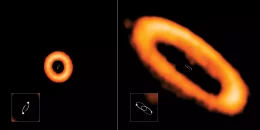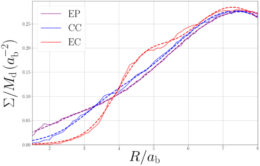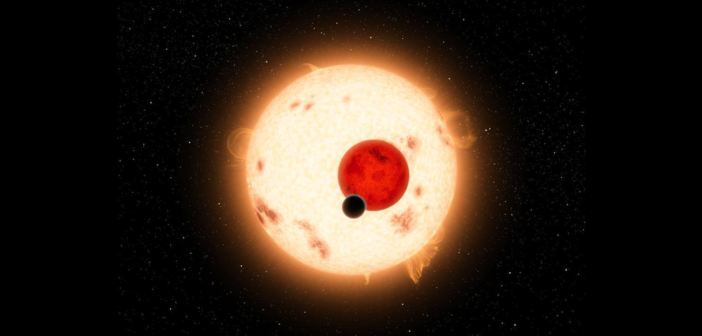Astronomers and science-fiction fans alike were delighted to discover that planets can exist in stable orbits around binary stars. Today’s article looks at circumbinary planets from a new angle — a 90-degree angle, to be exact.

Most circumbinary disks (orange) are aligned with the orbital plane of the binary (e.g., AK Sco, right), but we’ve also found disks oriented perpendicular to the orbital plane (e.g., HD 98800 B, left). Here orbits of the binary system are drawn in white for clarity. Click to enlarge. [ALMA (ESO/NAOJ/NRAO), I. Czekala and G. Kennedy; NRAO/AUI/NSF, S. Dagnello]
Planets at an Extreme Angle
The vast majority of disks observed around binary stars are aligned with the orbital plane of the binary, since angular momentum tends to be conserved as gas clouds collapse to form star systems and their surrounding protoplanetary disks. However, recent observations have found that binary star systems with elongated, eccentric orbits can maintain a protoplanetary disk perpendicular to the orbital plane of the binary system.
These observations suggest that perpendicular circumbinary planets exist, but astronomers have yet to detect any. What can simulations tell us about the likelihood of perpendicular planets forming, especially rocky, Earth-like planets close to their parent stars?
Simulating Systems in Formation
To explore the planet-forming potential of perpendicular disks relative to other configurations, Anna Childs and Rebecca Martin (University of Nevada, Las Vegas) simulated three scenarios involving circumbinary disks:
- In the same plane as a binary pair with a circular orbit (eccentricity e=0)

Distribution of disk material as a function of distance from the system center of mass for the eccentric perpendicular (EP), circular coplanar (CC), and eccentric coplanar (EC) scenarios. When the disk is oriented perpendicular to the orbital plane of the binary, more material is found closer to the binary. [Childs & Martin 2021]
- In the same plane as a binary pair with an eccentric orbit (e=0.8)
- Perpendicular to the plane of a binary pair with an eccentric orbit (e=0.8)
Childs and Martin first performed hydrodynamic simulations to determine how the disk material would be distributed in the early stages of planet formation for each of these three cases. The authors then used these results to guide the placement of 26 Mars-sized and 260 Moon-sized objects within the simulated disk — the mass and size distribution thought necessary to form the terrestrial planets in our solar system. In the final N-body simulation, the authors let these planetesimals loose and watched their planet-forming journey.

Simulated particle orbits for the case of a planet-forming disk perpendicular to the orbit of an eccentric binary after 10,000 years (top) and seven million years (bottom). [Adapted from Childs & Martin 2021]
More Likely Than You Might Think
Over the course of seven million simulated years, material in the fledgling planetary systems collided with the host stars, clumped together to form larger bodies, or was ejected from the systems altogether. The result? Disks oriented perpendicular to the orbital plane of an eccentric binary formed more planets than disks in the same plane as the binary orbit.
On average, the perpendicular disks formed 4.8 terrestrial planets while the coplanar disks formed only 3.4. The difference likely arises from the increased torque that the binary applies to the disk in the coplanar case — more torque means more material gets ejected from the disk. Neither scenario formed as many terrestrial planets as the circular coplanar case, but it’s clear that close-in, rocky planets can exist in orbits perpendicular to their host binary system. Even taking into account the complicating effects of general relativity, which cause eccentric binary systems to precess over time, the perpendicular system retained its terrestrial planets.
Childs and Martin note that detecting planets in this configuration with current techniques is difficult, but not impossible — hopefully the discovery is just around the corner!
Citation
“Formation of Polar Terrestrial Circumbinary Planets,” Anna C. Childs and Rebecca G. Martin 2021 ApJL 920 L8. doi:10.3847/2041-8213/ac2957
